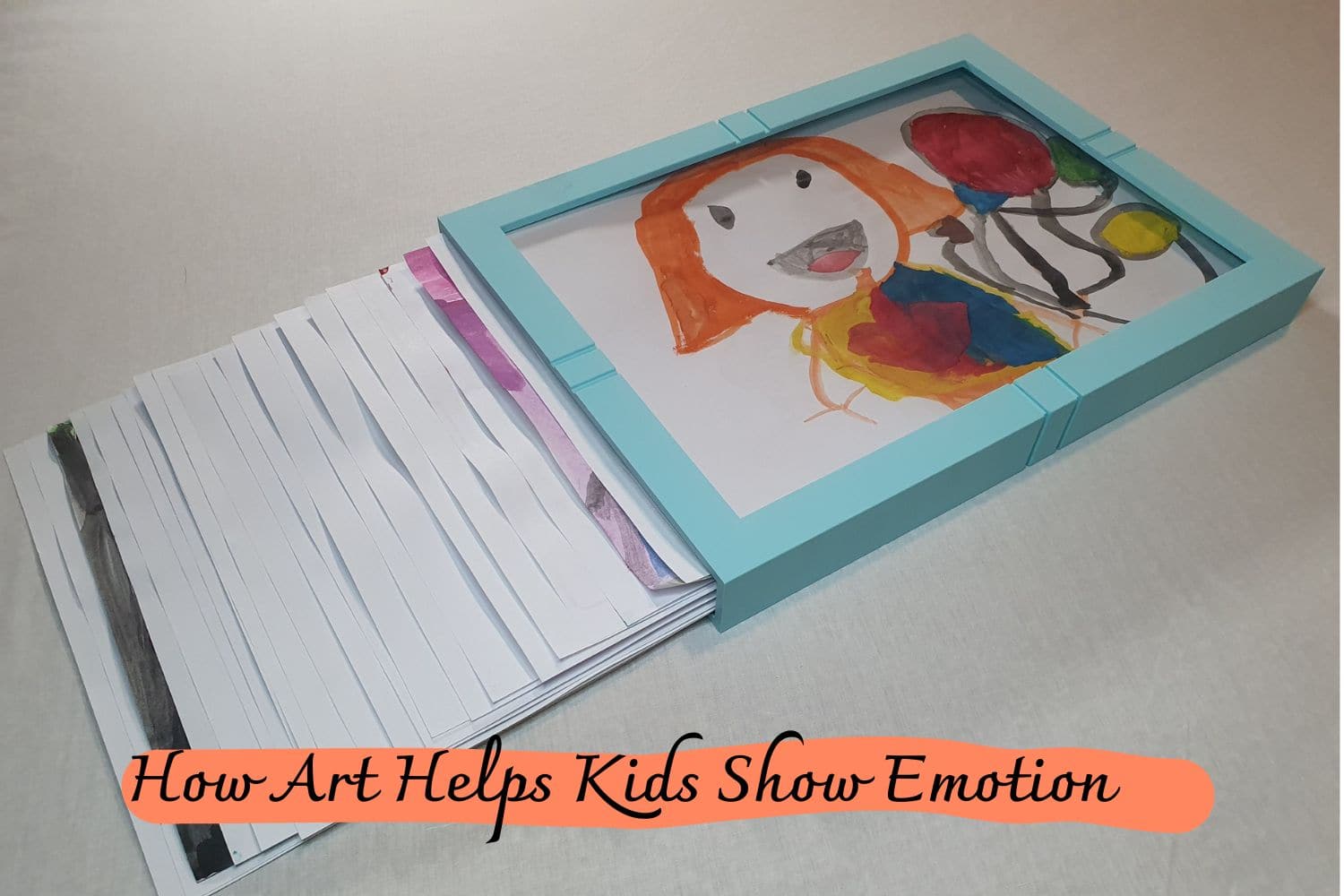Not sure how to help your child express their feelings? Discover how art helps kids show emotion without words.
How Art Helps Kids Show Emotion

Do you remember the first time you created something with your hands as a child? Maybe it was an art project for school or a drawing in the sand on the beach.
Childhood art is often filled with emotion and expression, helping kids make sense of their feelings while developing bigger creative skills. Creating artwork from scratch allows us to express ourselves without words and can be incredibly inspiring, comforting, positive – and even revolutionary!
In this blog post, we explore how art helps kids show emotion and develop their voices. We’ll look at why art is fundamental for emotional development in young minds, as well as some easy ways for parents to inspire creativity in their kids.
Hopefully, by the end of this piece, we can all appreciate just how valuable artistic expression is!
Expressing Emotions Through Art: Helping Children Communicate
Children often struggle to articulate their emotions, leaving complex feelings unspoken. Instead, these emotions may manifest physically, through symptoms like stomachaches, nail biting, and hypervigilance. With these challenges, behavior changes such as anger, withdrawal, lack of focus, or lethargy often occur.
But how can we help children express and process these experiences in healthy ways?
One effective method is to encourage children to use art as a means of communication. By creating art, they can effectively express their thoughts and feelings, allowing for constructive exploration and growth.
How Art Helps Kids Show Emotion
When faced with challenging experiences, we can all feel overwhelmed and powerless at times. This is especially true for children, who may struggle to effectively manage their emotions. However, there is a powerful tool that can help them reframe and reconceptualize these difficult experiences in a positive way: art.
However, Cathy highlights the transformative power of art in reframing and reconceptualizing these experiences in a positive light. The visual language of art – with its vibrant colors, expressive shapes, fluid lines, and captivating images – speaks to us in ways that words simply cannot. This is where art therapy comes into play, using the nonverbal language of art as a means of personal growth, insight, and transformation. It allows us to bridge the gap between our inner thoughts, feelings, and perceptions, and the outer realities and experiences of our lives.
Art engages children naturally and safely, providing them with a means to express themselves. In this creative space, they can freely play, experiment, make a mess, concoct stories, use metaphors to convey emotions, explore different narratives, create characters to externalize their feelings, reflect on their experiences, and even share their art with others. The possibilities for expression are vast, ranging from the use of color, texture, and different materials to the incorporation of found objects, photographs, collages, sculptures, or film. Each child or group of children can adapt these artistic methods to suit their unique needs.
By embracing art as a therapeutic tool, we empower children to navigate their emotional terrain with confidence and resilience. Through their creations, they can find solace, understanding, and a renewed sense of self. Art truly can guide them toward healing and growth.
Exploring Your Child’s Mind with Art
Content
Figurative art offers a glimpse into the thoughts of the artist. By understanding your child’s likes and dislikes, you can analyze their artwork and gain valuable insights.
Engage in a conversation with your child to understand what motivated them to choose a particular subject. If they consistently draw fairies or dinosaurs, it indicates a sense of comfort and enjoyment in depicting subjects that bring them happiness.
If your child introduces a new and unfamiliar subject, it may signify their curiosity and the desire to expand their interests.
By delving into the world of figurative art, you can better understand your child’s thoughts and emotions, fostering a deeper connection and appreciation for their artistic expression.
Decoding Shapes and Styles
When faced with abstract artwork that lacks an obvious subject, pay close attention to the shapes and angles utilized.
Soft, curved lines often convey a sense of tranquility and passive energy, while sharp, angular pictures may imply heightened mental activity.
It’s important to note that this mental activity isn’t necessarily negative emotions, like anger or frustration, but could simply represent energy and enthusiasm.
Moreover, the amount of detail in a completed picture can reveal the level of mental activity within a child’s mind. Excessively busy artwork may suggest a mind in need of stimulation and exercise.
Meaning of Colors
Colors have been imbued with significance by various cultures and periods, making them a powerful tool for self-expression. Artists often use colors and shades to convey emotions, making it important to pay attention to the preferences and associations that children have with different hues.
While bright, warm colors typically represent positive and joyful feelings, darker shades often evoke a sense of melancholy. However, it’s crucial to remember that every individual is unique, and personal taste plays a big role in color interpretation.
As adults, we assign certain meanings to visual stimuli, whether it’s a specific color like black or red, or different patterns like zig-zags or bubbles. However, it is equally important to familiarize ourselves with a child’s interests and the meanings they attach to these visual elements.
By understanding the symbolism behind colors and respecting each child’s associations, we can create a more meaningful and enriching artistic experience.
Conclusion
Art is an amazing tool for kids of all ages to express their emotions and feelings. No matter what age or how experienced they are, art can be used as a positive outlet to show emotion without words.
It’s important to help children harness this power to work through their emotions healthily. Encourage kids to draw, paint, create sculptures, and experiment with different materials that make them feel good as an outlet for any difficult feelings they may have.
Supporting children in their use of art can foster self-expression and allow them to communicate without the limitations of language.
Overall, no matter the type of art, it’s clear that giving kids a creative platform will not only enrich their lives but also build self-esteem and provide them with invaluable skills that will stick with them forever.
Thanks for reading our article How Art Helps Kids Show Emotion. If you want to know more information, visit our website here.
Read more:
Exploring children’s feelings through art
6 ways to help your kids use art to express their feelings about the pandemic
